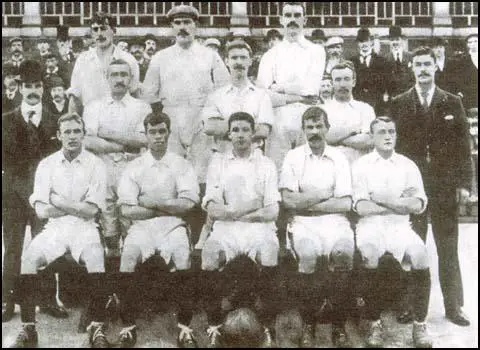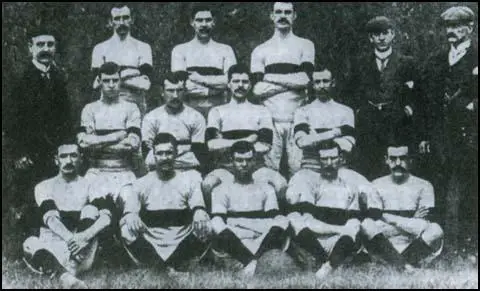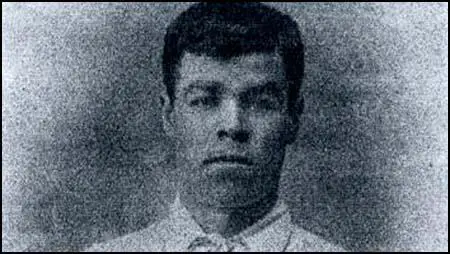Fred Corbett

Herbert Frederick Corbett was born in Mile End in the fourth quarter of 1879. His father was Frederick Corbett (born c. 1845, Stourbridge, Worcestershire, and died in 1901, in Poplar, East London). He worked as a "carman" (a man who transported goods by horse and cart).
Fred Corbett's mother, Eliza, was born in the St Luke's district of London between 1845 and 1848. She was probably Frederick Corbett's "common law" wife as there is no record of a marriage. (1)
Corbett played his first football for the youth team of Old St Luke's FC. In 1894, church-based Old St Luke's merged with Castle Swifts, the football team based at the Castle Shipping Line repair yard in Bow Creek, and the new club, Old Castle Swifts, played its home matches at Hermit Road in Canning Town. (2)
Fred Corbett, who was living with his parents at 6A Forty Acre Lane, West Ham, when he found work as a labourer at the Thames Iron Works and Shipbuilding Company in Canning Town. It was London's last surviving major shipbuilding firm. In 1860 it had employed 6,000 men, but by 1895 it was half that number, and was suffering from serious competition from companies based on the River Clyde and in the North East of England. (3)
In 1899 Corbett joined the Thames Ironworks football team who played in the Southern League. Arnold Hills, the managing director of the company, had established the football club in 1895. Hills, who had been involved in a bitter industrial dispute with his employees that year, thought that the formation of a football club might help improve the mood of his workforce. James Walvin argues in The People's Game (1994): "The football club was founded in 1895 as part of Hills's belief in the importance of cooperation between workers and management. The game would, he believed, be useful (and enjoyable) for the workers and beneficial for the company". (4)
On 29th June, 1895, Hills announced in his newspaper, the Thames Ironworks Gazette, that he intended to establish a football club. The information appeared under the headline: "The importance of co-operation between workers and management". He referred to the dispute that had just taken place and insisted he wanted to "wipe away the bitterness left by the recent strike". Hills added: "Thank God this midsummer madness is passed and gone; inequities and anomalies have been done away with and now, under the Good Fellowship system and Profit Sharing Scheme, every worker knows that his individual and social rights are absolutely secured." (5)
Fred Corbett a winger or inside forward, played his first game for the Thames Ironworks aged 19 on 16th September, 1899, against Reading in the Southern League Division 1. This was followed by games against Chatham Town (18th September 1899) and Bristol City (2nd December, 1899). He failed to score in these three games and was dropped from the first team. He did, however, play consistently for the reserves in the London League and was top scorer for them. (6)
According to Phil Vasili, the author of Colouring Over the White Line: The History of Black Footballers in Britain (2000), Fred Corbett was only the third black footballer after Andrew Watson and Arthur Wharton to play in league football in England. (7)
The following season Arnold Hills decided to change the name of his football club to West Ham United. Hills reluctantly accepted the need to employ highly paid professionals. He wrote: "The committees of several of our clubs, eager for immediate success, are inclined to reinforce their ranks with mercenaries. In our bands and in our football clubs, I find an increasing number of professionals who do not belong to our community but are paid to represent us in their several capacities." (8)

Fred Corbett, a young man living in the area was just the sort of man Arnold Hills wanted in the team and became a regular in the 1900-1901 season. He scored his first goal against Swindon Town on 6th October, 1900. He scored again the following weekend in a 2-0 home success against Watford. He went on to score five more goals in the league. By the end of the season West Ham United was in sixth place behind Southampton, Bristol City, Portsmouth, Millwall and Tottenham Hotspur. Corbett played 21 games that season and scored a total of 7 goals. Only the great Billy Grassam scored more goals (15 goals) for West Ham that season. Corbett contributed two goals in West Ham good run in the FA Cup that season. Over 12,000 saw them draw 1-1 with Clapton Orient. West Ham won the 5th round replay 3-2 with Billy Grassam scoring a hat-trick. The next round saw the visit of mighty Liverpool. On 5th January 1901 and watched by a home crowd of 6,000, Liverpool won 1-0. (9)

Corbett got a hat-trick against Wellingborough Town at the beginning of the 1901-02 season. However, Syd King, the manager, often played George Radcliffe (24 games) and Fergus Hunt (15 games) instead of Corbett (12 games). West Ham United finished 4th with 40 points. The Hammers had a good defensive record but only scored 45 goals during the season. Corbett, scored six goals that season. However, one goal in every two games, was still impressive. (10)
In 1902 Corbett moved to Bristol Rovers. where he scored 6 goals in 26 appearances. The following season he moved to local rivals Bristol City who were in the Football League Division 2 at the time, where in two campaigns he made 49 appearances, scoring 16 goals. In 1905 he returned to London to play for Brentford in the Southern League, where he scored 39 goals in 81 matches over 3 seasons. (11)

In October 1906, The Daily Express reported on the ability of Fred Corbett to score goals: "There are few centre forwards the equal of the Brentford man, Fred Corbett. He is essentially an opportunist, quick to seize a chance and turn it to account. He has a special aptitude for taking advantage of a flaw in the opposite defence. Against Norwich City he scored both goals, the second point being of exceptional merit. He dashed through the backs, and scored with a fine shot before Archer and McEwen had realised that he had broken through them." (12)
After leaving Brentford in 1908 Corbett's career now went into decline and he played for a series on non-league clubs. However, in the 1911 Census Corbett described himself as a "Professional Footballer". (13) He played his last game in 1919 for Winsford United in the Cheshire League. Phil Vasili argues that during his career Corbett "played over 280 games, scoring 101 goals - a good rate for a winger". (14)
Fred Corbett, who had married Catherine Maud Taylor, a "laundry shop assistant" on 24th April 1904 moved back to London on his retirement as a footballer. (15) The 1921 Census records Fred and Catherine Corbett were living with their two daughters, Winifred (born 1905) and Irene (born 1909) at 65 Windmill Road, Brentford. Corbett decribes his occupation as a "Tyre Maker". (16)
Herbert Frederick Corbett died in Brentford on 15th April 1924 and he was buried at Ealing & Old Brentford Cemetery on 19th April 1924. His age at death was registered as "43 Years". (17)
Primary Sources
(1) David Simkin, Family History Research (7th October, 2024)
I think Fred Corbett might have had doubts about the exact date of his birth. One source on Ancestry states that he was born on 1st January 1881 and that is consistent with the 1881 Census return and his age given at death, but other records suggest he was born in Mile End in 1879 as Herbert Frederick Corbett.
Frederick Herbert Corbett was born in East London, either in 1879 or 1881. On census returns his place of birth is given either as Mile End, West Ham or Stepney. His father was Frederick Corbett (born c. 1845, Stourbridge, Worcestershire - died 1901, Poplar, East London) who worked as a "carman" (a man who transported goods by horse and cart). His mother, Eliza, was born in the St Luke's district of London between 1845 and 1848. She was probably Frederick Corbett's " common law " wife as there is no record of a marriage.
At the time of the 1881 Census, Eliza & Frederick Corbett were living at 53 Jubilee Street, Canning Town, East London, with their 3 children - Eliza Corbett, age 8 (born 1873, Mile End), Jessie Henrietta Corbett, age 6, (born 1875, Mile End) and Herbert aged 1 (Frederick Herbert Corbett).
The 1891 Census records the Corbett Family lodging at 48 Peter Street, West Ham - Herbert's age is given as "12".
The 1901 Census shows Frederick Corbett as a 21-year-old "Labourer in Ironworks", living with his parents at 6A Forty Acre Lane, West Ham.
Around 1902, Frederick Herbert Corbett was in Bristol.
On 24th April 1904, Frederick Herbert Corbett, a " Ship Builder" aged 23, married Kate (Catherine) Maud Taylor, aged 20, in Bristol.
The couple gave their address as 14 Woodborough Street, Bristol. Catherine Maud Taylor was born in the district of Chard in 1885, but she gives her place of birth as Bristol. She previously worked as a "laundry shop assistant".
The 1911 Census form shows Frederick Herbert Corbett, a 27 year-old "Professional Footballer", living at 9 Woodborough Street, Stapleton Road, Bristol, with his wife and two young daughters.
The 1921 Census records Frederick Corbett as a "Tyre Maker " living at 65 Windmill Road, Brentford, Middlesex. He gives his age as 38 years, 9 months.
The date of his death is more certain. Frederick Herbert Corbett died in Brentford, West London, on 15th April 1924 and he was buried at Ealing & Old Brentford Cemetery on 19th April 1924. His age at death was registered as "43 Years"
(2) Phil Vasili, Colouring Over the White Line: The History of Black Footballers in Britain (2000) page 58
While all the men so far discussed were undisputed footballers of colour, a similar assertion cannot be made for Fred Corbett. He has been included, however, because of his appearance in tem photographs, the final judgement resting with the reader. His first professional club was Thames Ironworks, later West Ham United. The team made up of workers at the Canning Town shipbuilders, was formed after a strike at the yard. The unspoken aim of the newly created 'Hammers' was to foster better relations between management and workers after a period of great militancy in the docks of East London.
Thames Ironworks turned professional in 1898 and joined Division Two of the Southern League for the start of the 1898-99 season. The total number of new players signed at this time was thirty, only three being retained from the previous campaign. Corbett, an 18-year-old goal-scoring right-winger, was employed the following season, at the end of which the club changed its name to West Ham United.
(3) John Powles, Iron in the Blood: Thames Ironworks FC (2005) page 89
Fred Corbett, born Stepney, August 1880. A strong, hardworking inside forward, Freddy joined Thames Ironworks from the junior side Old St Lukes's at the same time as James Bigden in 1899/1900, playing just three times in the Southern League side, and once in the Thames & Medway Combination without scoring. He did, however, play consistently for the reserves in the London League and was top scorer for them. When the club became West Ham United he blossomed and scored 13 goals in 33 appearances in the first team in two seasons before moving to Bristol Rovers in 1902 scoring 6 goals in 26 appearances. The following season he moved to local rivals Bristol City who were in the Football League Division 2 at the time, where in two campaigns he made 49 appearances, scoring 16 goals. He was back in London with Southern League Brentford in 1905 scoring 39 goals in 81 matches over 3 seasons, but returned to Bristol Rovers in 1908 staying for 3 years and scoring 36 goals from 97 outings. One season with New Brompton in 1911 followed with six goals from 22 appearances. His final season of 1912/13 saw him in Wales with Merthyr Town where he played in just two first team matches in the Southern League without scoring.
(4) The Daily Express (29th October 1906)
There are few centre forwards the equal of the Brentford man, Fred Corbett. He is essentially an opportunist, quick to seize a chance and turn it to account. He has a special aptitude for taking advantage of a flaw in the opposite defence. Against Norwich City he scored both goals, the second point being of exceptional merit. He dashed through the backs, and scored with a fine shot before Archer and McEwen had realised that he had broken through them.
(5) Fred Corbett, West Ham United's First Black footballer
(1st October 2024)
As Black History Month 2024 begins on 1 October, we share the story of Fred Corbett, who remains a hugely important figure in the history of West Ham United, one hundred years on from his death.
For Corbett was the first Black player to represent the Club as he played 38 games and scored 15 goals between September 1899 and December 1901.
Reportedly born in Stepney in August 1880, the young Corbett played his first football for the youth team of Old St Luke's FC in Canning Town. In 1894, church-based Old St Luke's merged with Castle Swifts, the football team based at the Castle Shipping Line repair yard in Bow Creek, and the new club, Old Castle Swifts, played its home matches at Hermit Road in Canning Town.
After turning professional in November 1894, Old Castle Swifts went bankrupt in March 1895. A few months later, Hermit Road became home to a newly formed works team, Thames Ironworks FC, and a number of Old Castle Swifts players moved from one to the other.
At the time, Corbett was just 14 and playing for Old St Luke's youth team, which continued to operate and provide an unofficial pathway to Thames Ironworks FC's senior squad. Among those who ‘gradated' from this ‘academy' in 1899 was an 18-year-old Corbett, who also worked as a labourer at Arnold Hills' shipyard.
Playing as a right winger, Corbett debuted for Thames Ironworks, wearing the No7 shirt in a 1-0 Southern League First Division defeat by Reading at Elm Park on 16 September 1899. Two days later, he started his first win as a Hammer in a 4-0 home win over Chatham at the Memorial Grounds.
In the summer of 1900, Thames Ironworks FC was wound up and relaunched as a professional club named West Ham United, and Corbett was one of the many players who moved from one to the other.
He scored his first goal on his second appearance for the ‘new' Hammers, grabbing the winner in a 1-0 Southern League First Division victory at Swindon Town on 6 October 1900, and netted again the following weekend in a 2-0 home success against Watford.
Corbett netted in both ties as West Ham overcame New Brompton in the FA Cup fourth qualifying round after a replay, and by the season's end he had scored nine goals in 23 appearances.
The 1901/02 season saw Corbett find the net on six more occasions, including his first career hat-trick in a 4-2 home victory over Wellingborough Town and two in a 4-2 win over Luton Town.
With interest in football booming, a crowd of 9,000 watched Corbett and his teammates face Millwall on 26 October 1901, and 17,000 turned out to see FA Cup holders Tottenham Hotspur edge out the Hammers a week later.
Corbett's playing opportunities dwindled thereafter, and he would turn out just twice more before joining Southern League rivals Bristol Rovers in December 1901.
He would turn out, and score at a rate of around one goal in every three appearances, for Bristol Rovers (in three separate spells), Bristol City, Brentford, Worcester City and New Brompton before closing out his nomadic career with Merthyr Town, Tranmere Rovers, Croydon Common and Winsford United.
Fred Corbett passed away in west London in April 1924, aged just 43, but his premature death does nothing to diminish the historic mark he has left on Thames Ironworks FC, West Ham United and English football as a whole.

